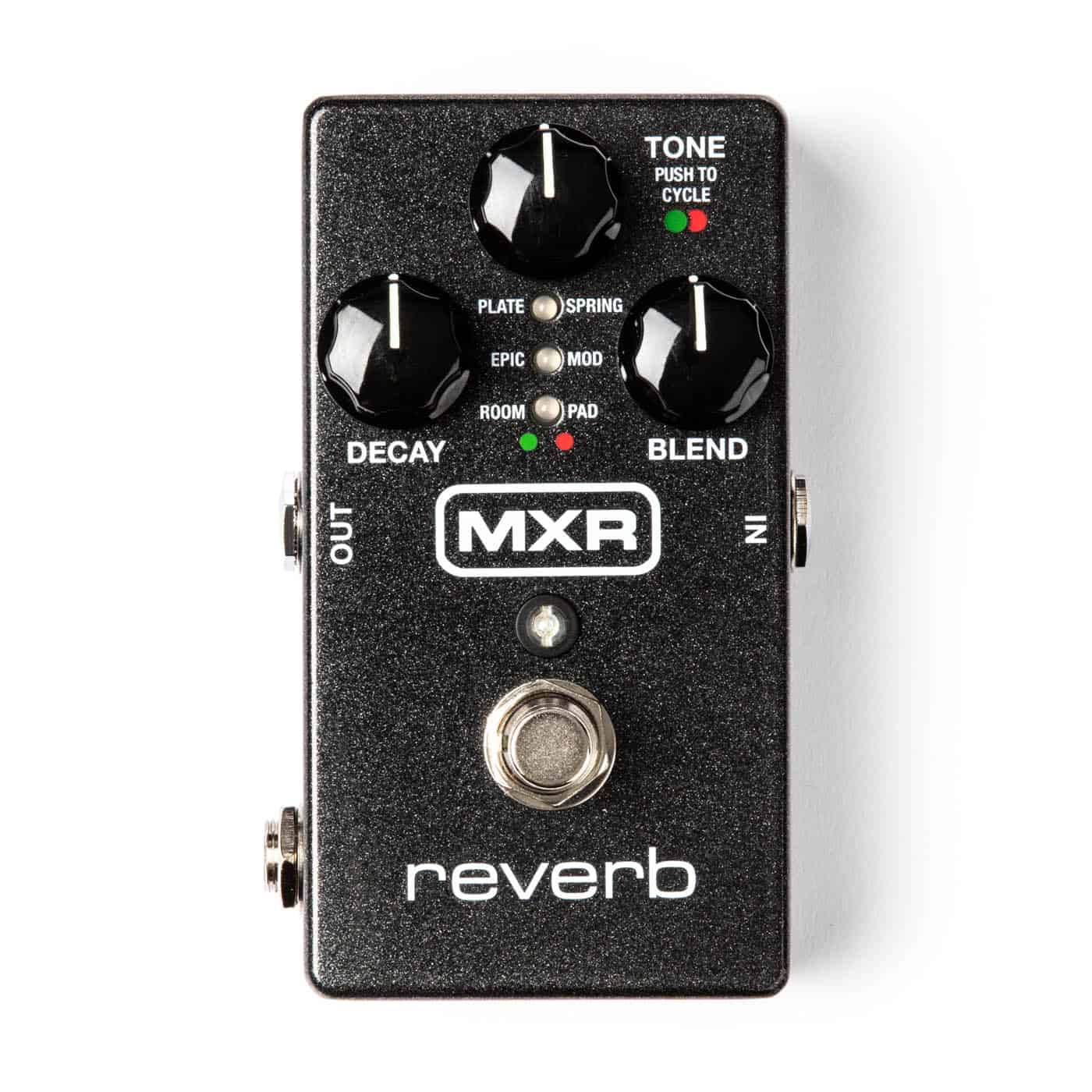
The MXR Reverb (sometimes referred to as the M300) is pedal legends MXR’s entry into the crowded reverb pedal market. In this review, I’ll describe the MXR Reverb’s features, some of the things I like about it, and some areas I think could be better. Let’s begin!
Features
The MXR Reverb offers mono/stereo in/out. It has three knobs – Mix (called Blend in some versions), Decay, and Tone. The knobs behave slightly differently in each mode, but generally do what you’d expect. It doesn’t take batteries, but it takes a standard 9V power supply – one is included with the pedal. It has an Expression In that can control reverb levels on the fly.
Echo Modes
The MXR Reverb has six reverb modes: Plate, Spring, Epic, Mod, Room, and Pad.
“Real” reverb modes
Plate mode emulates a plate reverb, and is probably the most versatile mode on the pedal. It’s a simple, smooth reverb effective for a wide range of applications.
Spring emulates the spring reverb found in classic amplifiers. I’m very impressed with the MXR Reverb’s spring mode. In my opinion, pedal manufacturers often fail to successfully emulate the sound of springs in their digital pedals, but the MXR Reverb is in a different class. I think the EHX Holy Grail is a little better, but the MXR sounds warm and bouncy – especially if you max out the Mix and Decay knobs.
Room mode is the most “natural” sounding reverb in the pedal. As the name suggests, it sounds like a big or small room, depending on how you set the Decay knob.
Not-so-“real” reverb modes
Epic mode is described on the pedal’s webpage as “a unique combination of multiple interwoven analog-tone delay lines and complex modulation”. It’s interesting, but I find it a little frustrating for reasons I’ll go into later.
Mod is a plate model with a little bit of modulation on the feedback. It’s my favorite mode on the pedal. It’s cold, clean, and perfectly balanced, but never boring. For intense “ambient” guitar applications, this is my go-to.
Pad mode is MXR’s take on the “shimmer” reverb originated by Daniel Lanois and Brian Eno. The reverb is pitchshifted up and down, then modulated. The end result is that your playing is “padded” with an ethereal, synth-y, organ-like bed, as though it is floating on clouds. It’s a really interesting sound and is fun to play around with, but it’s very busy and it can be hard to tell what to do with it.
Pros
The MXR Reverb sounds great, it’s very tweakable, and it’s simple enough not to be overwhelming. I tried dozens of reverb pedals and I settled on this one, because I felt like it had the best combination of tone and “fun” for the money. All in all, I’m very happy.
Cons
The MXR Reverb isn’t perfect – there are a few things I wish were different.
- First up, it requires high quality power. I’d strongly suggest you use an isolated power supply with this pedal. If you use it with a non-isolated power supply like a daisy chain or an MXR DC Brick you will get digital noise in your signal. There’s a chance I got a bad unit, and that other units don’t have the issue, but it’s important to mention.
- In most modes, the sound becomes muddy and indistinct if the mix/decay are high. The pedal’s tone knob doesn’t always help with this. I’ve improved the sound by rolling off some highs and lows with a Danelectro Fish & Chips EQ pedal.
- For the “Epic” and “Shimmer” modes I wish there were more parameters I could tweak. Their sounds have a lot of moving parts, but you can only manipulate one or two of them. I like to have more control over my tone, but I don’t yet understand how Epic and Shimmer respond to my playing, so I tend to avoid these modes.
Conclusion
A reverb pedal, when properly and creatively applied, can be an integral part of your sound. The MXR Reverb has a wealth of options to choose from, and at its price point it’s hard to beat. Check it out!

Comments (2)
Electro-Harmonix Canyon Delay & Looper – Pedal Review – Var Guitar
April 27, 2020 at 10:27 pm
[…] creating a wash of harmony. I haven’t found a shimmer sound I like (see my review of the MXR Reverb) and this one is no exception, but if you’re desperate for shimmer then this is a decent […]
Danelectro Fish and Chips EQ Pedal – Guitar Pedal Review – Var Guitar
April 27, 2020 at 10:33 pm
[…] like to place mine before my MXR Reverb pedal, since its Tone knob isn’t nearly precise enough for how big its sound is. By shelving […]
Comments are closed.